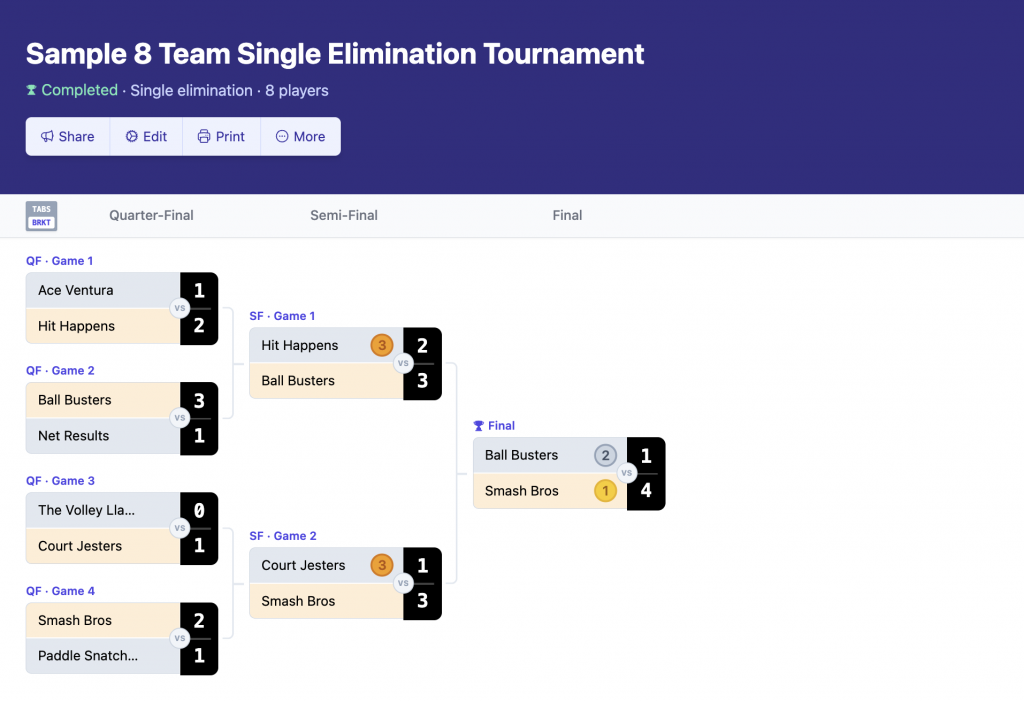About our Single-Elimination Tournament Generator
Our tournament maker app help you streamline the process of creation and management of any single-elimination tournament:
- any number of players or teams
- flexible pairing options: seeded, blind draw, or manual
- live score updates
- automatically advance players to the next round if they won
- optionally, have a 3rd place playoff

In addition to these core features, we also offer:
- export your single elimination bracket to PDF for printing or CSV/Excel for records
- display tournament schedule in a presentation mode for large screens
- let the organizer delegate scores keeping to other players or coaches
What is Single-Elimination Tournament?
A single-elimination tournament, also known as knockout or sudden-death tournament, is an elimination tournament format where the loser of each game leaves the tournament immediately.
Advantages
- Simple and fast: easy to set up and follow
- Exciting: every match can be the last one for a team
- Time-efficient: few matches comparing to other formats
- Universal: works with any number of players and teams
Disadvantages
- Harsh: out after one loss
- Less play time: especially for weaker participants
- Not always fair: when pairing is not balanced
How does Single-Elimination Tournament work?
Pairing
Initial pairing of the players is the most important part of the tournament: if done poorly, it can give advantage to some players.
There several ways to pair players:
- seeded: initial pairings are arranged so the strongest players are spread apart (they only meet in later rounds)
- blind draw: players or teams are paired randomly
- manual: participants are paired manually according to the organizer
Rounds
In elimination brackets, all rounds have the number of games that are power of 2: 2, 4, 8, 16, 32, etc.
Each round has it’s own name, normally called “Round of N” where “N” is number of players in this round. Then, there’re “Quarter-Final” (“Round of 8”), “Semi-Final” (“Round of 4”), and “Final” (“Round of 2”).
For 16 players, there are 4 rounds:
- Round of 16
- Quarter-Final
- Semi-Final
- Final
Byes
When there’s not enough players to fill in the brackets, some players advance to the next round automatically.
For example, with 6 players, bracket size is 8, so 2 players becomes byes and are moved to the 2nd round automatically.
Games
| Team | Rounds | BYEs | Games |
|---|---|---|---|
| 3 teams | 2 | 1 | 2 |
| 4 teams | 2 | — | 3 |
| 5 teams | 3 | 3 | 4 |
| 6 teams | 3 | 2 | 5 |
| 7 teams | 3 | 1 | 6 |
| 8 teams | 3 | — | 7 |
| 9 teams | 4 | 7 | 8 |
| 10 teams | 4 | 6 | 9 |
| 11 teams | 4 | 5 | 10 |
| 12 teams | 4 | 4 | 11 |
| 13 teams | 4 | 3 | 12 |
| 14 teams | 4 | 2 | 13 |
| 15 teams | 4 | 1 | 14 |
| 16 teams | 4 | — | 15 |
| 17 teams | 5 | 15 | 16 |
| 18 teams | 5 | 14 | 17 |
| 19 teams | 5 | 13 | 18 |
| 20 teams | 5 | 12 | 19 |
| 21 teams | 5 | 11 | 20 |
| 22 teams | 5 | 10 | 21 |
| 23 teams | 5 | 9 | 22 |
| 24 teams | 5 | 8 | 23 |
| 25 teams | 5 | 7 | 24 |
| 26 teams | 5 | 6 | 25 |
| 27 teams | 5 | 5 | 26 |
| 28 teams | 5 | 4 | 27 |
| 29 teams | 5 | 3 | 28 |
| 30 teams | 5 | 2 | 29 |
| 31 teams | 5 | 1 | 30 |
| 32 teams | 5 | — | 31 |
Rankings
In single elimination format only 1st and 2nd places are reliable determined, 3rd and 4th — only if 3rd place playoff is added.
3rd place playoff
Sometimes there’s a 3rd place or bronze match: two losers of the semifinals play to see who wins. Alternatively, they can share the 3rd place without playing.
Single-Elimination vs Round Robin Format
The key difference is in the number of games participants get to play: in single elimination the better you play, the more games you will have, while in round robin everyone plays the same number of games.
In elimination format you win if you get to the end of the tournament; in round robin — if you won the most points.